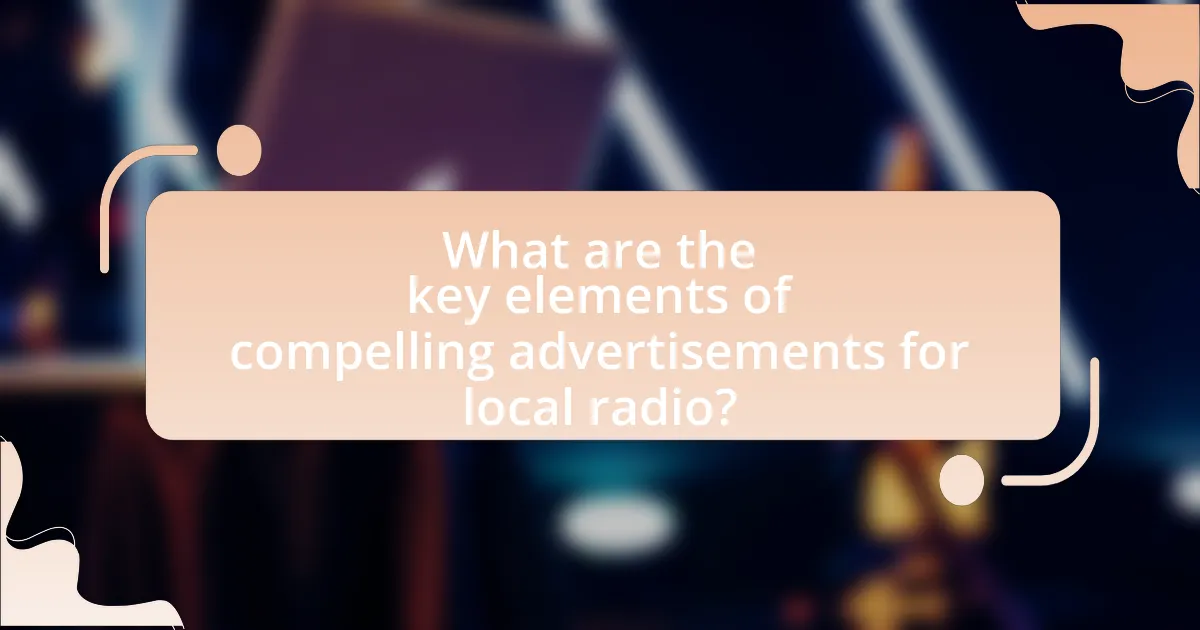The article focuses on creating compelling advertisements for local radio, emphasizing key elements such as clear messaging, emotional appeal, local relevance, and strong calls to action. It defines a compelling advertisement as one that captures attention and prompts listener engagement through relatable content and effective storytelling. The article also discusses the importance of audience targeting, demographic considerations, and the role of creativity and sound elements in enhancing advertisement effectiveness. Additionally, it outlines best practices for structuring radio ads, measuring their success, and aligning them with local culture and values, while highlighting common pitfalls to avoid.

What are the key elements of compelling advertisements for local radio?
Compelling advertisements for local radio include clear messaging, emotional appeal, local relevance, and a strong call to action. Clear messaging ensures that the audience quickly understands the product or service being promoted, while emotional appeal connects with listeners on a personal level, increasing engagement. Local relevance is crucial, as it makes the advertisement relatable to the community, often incorporating local events or landmarks. A strong call to action prompts immediate response from listeners, encouraging them to take specific steps, such as visiting a website or calling a number. These elements are supported by research indicating that advertisements with emotional resonance and local ties significantly enhance listener recall and response rates.
How do you define a compelling advertisement in the context of local radio?
A compelling advertisement in the context of local radio is defined as a message that effectively captures the attention of the target audience while conveying a clear and persuasive call to action. This type of advertisement utilizes engaging storytelling, relatable content, and local relevance to resonate with listeners, thereby increasing the likelihood of consumer response. Research indicates that advertisements that incorporate local references and community involvement can enhance listener engagement, as evidenced by a study from the Radio Advertising Bureau, which found that local ads are perceived as more trustworthy and relevant by audiences.
What characteristics make an advertisement stand out on local radio?
An advertisement stands out on local radio by being concise, engaging, and relevant to the target audience. Conciseness ensures that the message is delivered quickly, capturing listeners’ attention before they tune out. Engaging content, such as storytelling or humor, resonates with listeners, making the ad memorable. Relevance to local culture or community events enhances connection, as studies show that localized content increases listener engagement by up to 30%. Additionally, using a strong call to action prompts immediate response, further increasing the ad’s effectiveness.
How does audience targeting influence advertisement effectiveness?
Audience targeting significantly enhances advertisement effectiveness by ensuring that marketing messages reach the most relevant consumers. When advertisements are tailored to specific demographics, interests, and behaviors, they resonate more with the intended audience, leading to higher engagement rates. For instance, a study by the Interactive Advertising Bureau found that targeted ads can increase conversion rates by up to 50% compared to non-targeted ads. This precision in targeting not only improves the likelihood of consumer response but also optimizes advertising spend, as resources are focused on audiences most likely to convert.
Why is understanding your audience crucial for local radio advertisements?
Understanding your audience is crucial for local radio advertisements because it enables advertisers to tailor their messages effectively, ensuring relevance and engagement. When advertisers know the demographics, preferences, and behaviors of their target audience, they can create content that resonates, leading to higher response rates. For instance, a study by the Radio Advertising Bureau found that ads specifically designed for a target demographic can increase listener recall by up to 50%. This targeted approach not only enhances the effectiveness of the advertisement but also maximizes the return on investment for local businesses.
What demographic factors should be considered when creating radio ads?
When creating radio ads, key demographic factors to consider include age, gender, income level, education, and geographic location. These factors influence the preferences and behaviors of the target audience, allowing advertisers to tailor messages effectively. For instance, a study by Nielsen indicates that different age groups respond uniquely to various advertising styles, with younger audiences favoring more dynamic and engaging content, while older demographics may prefer straightforward and informative messaging. Additionally, understanding income levels can help in positioning products or services appropriately, as higher-income groups may be targeted with premium offerings, while budget-friendly options can appeal to lower-income audiences.
How can listener preferences shape advertisement content?
Listener preferences significantly shape advertisement content by guiding the themes, language, and delivery methods used in ads. Advertisers analyze listener demographics, interests, and feedback to tailor messages that resonate with the audience. For instance, a study by Nielsen found that ads aligned with listener preferences can increase engagement by up to 30%, demonstrating that understanding audience tastes leads to more effective advertising strategies. By incorporating familiar music styles or relatable narratives, advertisers can enhance the emotional connection with listeners, ultimately driving better response rates and brand loyalty.
What role does creativity play in crafting radio advertisements?
Creativity is essential in crafting radio advertisements as it captures audience attention and enhances message retention. Creative elements, such as unique storytelling, catchy jingles, and engaging sound effects, differentiate advertisements in a crowded audio landscape. Research indicates that ads with high creativity levels can increase brand recall by up to 50%, demonstrating the effectiveness of innovative approaches in advertising. Thus, creativity not only makes radio ads memorable but also drives consumer engagement and response.
How can storytelling enhance the impact of a radio ad?
Storytelling enhances the impact of a radio ad by creating an emotional connection with the audience, which increases engagement and retention of the message. When a narrative is woven into an advertisement, it allows listeners to relate personally to the characters and situations, making the message more memorable. Research indicates that ads utilizing storytelling can improve recall by up to 22 times compared to non-narrative ads, as demonstrated in a study by the Wharton School of Business. This emotional resonance not only captures attention but also fosters brand loyalty, as consumers are more likely to remember and respond positively to brands that tell compelling stories.
What techniques can be used to capture attention quickly in audio format?
To capture attention quickly in audio format, techniques such as using a strong hook, incorporating sound effects, and employing a dynamic voice can be effective. A strong hook, such as an intriguing question or a bold statement, immediately engages listeners and piques their curiosity. Sound effects enhance the auditory experience, making the content more memorable and stimulating. Additionally, a dynamic voice with varied tone and pace can maintain listener interest and convey enthusiasm, which is crucial in advertising. Research indicates that advertisements with engaging audio elements can increase listener retention by up to 50%, demonstrating the effectiveness of these techniques in capturing attention.

How can you effectively structure a radio advertisement?
To effectively structure a radio advertisement, begin with a clear and engaging hook that captures the listener’s attention within the first few seconds. This should be followed by a concise introduction of the product or service, highlighting its key benefits. Next, incorporate a compelling call to action that encourages immediate response, such as visiting a website or calling a number. Finally, ensure the advertisement concludes with a memorable tagline or jingle that reinforces brand identity. Research indicates that advertisements with a strong opening and clear call to action can increase listener engagement by up to 30%, making this structure particularly effective.
What are the essential components of a successful radio ad script?
The essential components of a successful radio ad script include a clear message, engaging hook, target audience identification, call to action, and concise length. A clear message ensures that the primary idea is communicated effectively, while an engaging hook captures the listener’s attention within the first few seconds. Identifying the target audience allows the script to resonate with specific demographics, enhancing relevance. A strong call to action prompts listeners to take the desired next step, such as visiting a website or making a purchase. Finally, maintaining a concise length is crucial, as radio ads typically range from 30 to 60 seconds, necessitating brevity to retain listener interest. These components collectively contribute to the effectiveness of radio advertisements.
How should you start a radio ad to grab listener attention?
To grab listener attention in a radio ad, start with a strong hook, such as an intriguing question or a bold statement. Research indicates that opening with a question engages listeners immediately, prompting them to think and connect with the message. For example, asking, “Are you tired of high energy bills?” directly addresses a common concern, making the audience more likely to pay attention. This technique is supported by studies showing that ads with engaging openings increase listener retention and response rates.
What is the importance of a clear call to action in radio advertisements?
A clear call to action in radio advertisements is crucial because it directs listeners on what steps to take next, enhancing the likelihood of engagement. Without a specific instruction, such as visiting a website or calling a number, the effectiveness of the advertisement diminishes, as listeners may not know how to respond. Research indicates that advertisements with a clear call to action can increase response rates by up to 50%, demonstrating its significant impact on consumer behavior.
How can sound elements enhance the effectiveness of radio ads?
Sound elements enhance the effectiveness of radio ads by capturing attention, evoking emotions, and reinforcing brand identity. The use of music, sound effects, and vocal tones can create a memorable auditory experience that resonates with listeners. For instance, studies show that ads featuring catchy jingles can increase brand recall by up to 50%. Additionally, sound effects can create vivid imagery, making the message more relatable and engaging. Research from the Journal of Advertising Research indicates that emotional responses triggered by sound can lead to higher purchase intentions, demonstrating the significant impact of sound elements in radio advertising.
What types of sound effects can be used to create an engaging atmosphere?
Sound effects that can create an engaging atmosphere include ambient sounds, nature sounds, and thematic soundscapes. Ambient sounds, such as city noise or background chatter, establish a setting and immerse listeners in a specific environment. Nature sounds, like birds chirping or water flowing, evoke tranquility and connection to the outdoors. Thematic soundscapes, which combine various elements like music, dialogue, and effects, enhance storytelling and emotional impact. Research indicates that sound design significantly influences listener engagement and retention, making these effects crucial for compelling advertisements in local radio.
How does music selection impact listener perception of the advertisement?
Music selection significantly influences listener perception of advertisements by evoking emotions and shaping brand associations. Research indicates that specific genres or tempos can enhance recall and affective responses; for instance, upbeat music often creates positive feelings, making the advertisement more memorable. A study published in the Journal of Advertising Research found that advertisements paired with congruent music—music that matches the advertisement’s message—resulted in higher purchase intentions among listeners. This demonstrates that the right music not only captures attention but also reinforces the intended message, ultimately affecting consumer behavior.

What strategies can be employed to measure the success of radio advertisements?
To measure the success of radio advertisements, businesses can employ strategies such as tracking listener response rates, analyzing sales data, and conducting surveys. Listener response rates can be monitored through unique phone numbers or promotional codes mentioned in the ads, allowing businesses to quantify direct engagement. Analyzing sales data during and after the advertisement campaign can reveal correlations between ad airing and sales spikes, providing concrete evidence of effectiveness. Additionally, conducting surveys to gather listener feedback on brand recall and perception can offer qualitative insights into the advertisement’s impact. These methods collectively provide a comprehensive view of radio advertisement success.
How can you track listener engagement with your radio ads?
To track listener engagement with radio ads, utilize methods such as surveys, call-to-action responses, and digital analytics. Surveys can be conducted post-ad airing to gather listener feedback and gauge recall, while call-to-action responses, such as unique phone numbers or website links, can measure direct engagement. Additionally, integrating digital platforms allows for tracking online behavior related to the ad, providing insights into listener interaction. According to a study by the Radio Advertising Bureau, 70% of listeners recall ads when they include a specific call-to-action, demonstrating the effectiveness of these tracking methods.
What metrics are most useful for evaluating advertisement performance?
The most useful metrics for evaluating advertisement performance include Return on Investment (ROI), Click-Through Rate (CTR), Conversion Rate, and Customer Acquisition Cost (CAC). ROI measures the profitability of an advertisement by comparing the revenue generated to the cost of the ad, providing a clear indication of financial effectiveness. CTR indicates the percentage of viewers who clicked on the ad, reflecting its engagement level. Conversion Rate measures the percentage of users who completed a desired action after interacting with the ad, showcasing its effectiveness in driving actions. CAC calculates the cost associated with acquiring a new customer through the advertisement, helping assess the efficiency of marketing spend. These metrics are essential for understanding the impact and effectiveness of advertising campaigns.
How can feedback from listeners inform future advertisement strategies?
Feedback from listeners can significantly inform future advertisement strategies by providing insights into audience preferences and engagement levels. Analyzing listener feedback, such as surveys or social media interactions, allows advertisers to identify which messages resonate most effectively, leading to more targeted and relevant advertising content. For instance, a study by Nielsen found that ads tailored based on audience feedback can increase listener recall by up to 50%. This data-driven approach ensures that future advertisements align closely with listener interests, ultimately enhancing the effectiveness of advertising campaigns on local radio.
What are some best practices for creating effective local radio advertisements?
Effective local radio advertisements should be concise, engaging, and tailored to the target audience. Utilizing a clear and compelling message within a 30 to 60-second timeframe ensures that listeners grasp the key points quickly. Incorporating local references and relatable language enhances connection with the audience, making the advertisement more memorable. Additionally, including a strong call to action prompts immediate response, which is crucial for driving customer engagement. Research indicates that advertisements with a clear call to action can increase response rates by up to 30%. Finally, using sound effects and jingles can create a distinctive auditory identity, reinforcing brand recognition and recall among listeners.
How can you ensure your advertisement aligns with local culture and values?
To ensure your advertisement aligns with local culture and values, conduct thorough research on the community’s traditions, beliefs, and preferences. This involves engaging with local stakeholders, such as community leaders and residents, to gain insights into cultural nuances. For instance, a study by the American Marketing Association highlights that advertisements reflecting local customs can increase consumer trust and engagement by up to 30%. Additionally, utilizing local dialects and symbols in your messaging can enhance relatability and resonance with the audience.
What common pitfalls should be avoided when creating radio ads?
Common pitfalls to avoid when creating radio ads include excessive length, lack of clarity, and failure to engage the audience. Excessive length can lead to listener disengagement; studies show that ads longer than 30 seconds often lose audience attention. Lack of clarity in messaging can confuse listeners, making it essential to communicate the core message succinctly. Additionally, failing to engage the audience through relatable content or a strong call to action can result in ineffective ads, as engagement is crucial for prompting listener response.